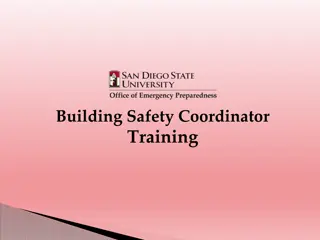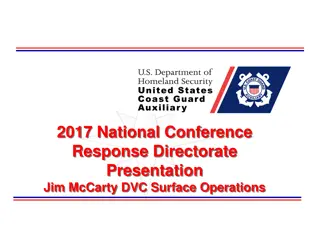Safety Guidelines and Preflight Procedures for Glider Operations
Safety guidelines and preflight procedures are crucial for glider operations to ensure a safe flying experience. Topics covered include the responsibilities of the safety committee, legality and club guidelines, preflight checks, common issues encountered, ground handling practices, and wingrunning procedures for towplane operations. Adhering to these protocols helps maintain a high standard of safety and operational efficiency in gliding activities.
Download Presentation

Please find below an Image/Link to download the presentation.
The content on the website is provided AS IS for your information and personal use only. It may not be sold, licensed, or shared on other websites without obtaining consent from the author. Download presentation by click this link. If you encounter any issues during the download, it is possible that the publisher has removed the file from their server.
E N D
Presentation Transcript
OPERATIONS AND SAFETY SAFETY COMMITTEE: JONATHAN LEAL, ROB DUNNING AND DANIEL SAZHIN
LEGALITY AND CLUB GUIDELINES When is your Biennial Flight Review due? Did you do three takeoffs and landings in the preceding 90 days? Club guidelines do not allow you to fly until you get a check-out with check pilot FAA does not allow flying with a passenger if not current If you crash while flying out of BFR or with a passenger while not current, the insurance might not pay! If you haven t flown in a while or feel uncomfortable, speak up on the e- group and someone will accommodate.
PREFLIGHT (1/2) Preflight is essential. These are club gliders! Something could be broken or different every time Checklists available for each glider If you are taking a glider after someone else, check independently. Just because they flew does not automatically make the glider airworthy! Especially check Attachment bolts- Elevator, horizontal stabilizer, wings, ailerons, etc Tire pressure and skid condition Tip wheels/tail wheels Condition of seals
PREFLIGHT (2/2) Issues in recent times: Rudder lock in glider (1-34R) TE Probe put in Pitot hole (Greta) Foam doodle on aileron pushrod (Red) Statics taped over (Red) Ballast weight in/out (1-34) Aileron lock on wing on grid (508) Stories from the crowd? It can happen to you!
GROUND HANDLING Slow-walking pace Go around the hill, not down the hill. If you go down the hill, don t hold the wing back! Tie spoilers open using belts (Insert B4 and 2-33 stories here) Canopy always closed and locked The most useless thing to a pilot is:______ Use tiedown ropes on the grid There are ropes available near the trailers for staging. Keep spoilers open on the grid
WINGRUNNING Do the course at: http://www.soaringsafety.org/learning/wingrunner/wingrunner.html Specifics at Blairstown: Wait for the towplane to pass beyond the wing tip. Walk to the rope. Wait for the towplane to do its 180. Once it does, pick up the end of the rope and go to the glider Show the ring to the pilot. Use big ring for Schweizers and extension for glass. Hook-up. Then go to the wingtip Look around for airplane and glider traffic in the pattern or staging. When the slack is out, look at the pilot and thumbs up. Lift wing by the tip of the trailing edge. Look for towplane rudder waggle, then glider waggle. Wave arm in circular manner. RUN with the wing. Don t push against the pilot. Until you lift the wing and wave your arm, you re the boss of the operation! If you see unsafe condition on glider, towplane or possible traffic, PUT THE WING DOWN!
TAKEOFF Get in the glider when third on the grid. Be completely ready when the towplane comes to you. Make sure to do pre-takeoff checklist. Usually available on the panel. I do: Altimeter Set, Belts on and Secure, Controls checked, Divebrakes closed and locked, Flaps set for takeoff, Trim set, Canopy closed and locked, Emergency plan You re the boss. If in doubt, release! Once rolling, get the glider as soon as practicable off of the ground.
TOW Do you have an emergency plan? Trees are better than 180 below 200ft! 200ft is bare minimum for turn around. Usually safer to go higher Don t get high on the towplane! Release if out of sight Look left and right before releasing. Turn right after release.
PATTERN What s going to kill you in flying? Hitting the ground! Make the decision to land when you have energy. Keep a safe amount of energy in altitude and airspeed in the approach Gliders have great airbrakes. Use em! Watch out for airplane and glider traffic If practicable, announce downwind
LANDING Avoid rolling over the taxiway if possible. Land before or after. No shame in going long! Land with as little energy as practicable When on the ground, fly to a stop!!!! Stick should be all the way back Taxi off of the runway Don t point at anything expensive Don t use excessive braking. Don t trust the wheelbrake When stopped, get out and pull the glider off of the runway!
MISCELLANEOUS When you see someone need to launch or get off the runway, help! If something is unsafe or broken, let others know. Stay safe!






















